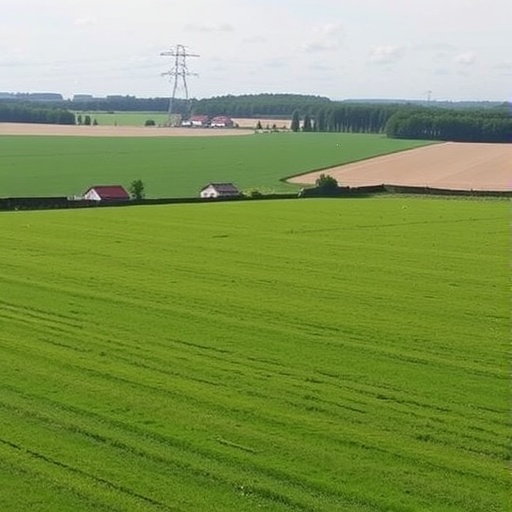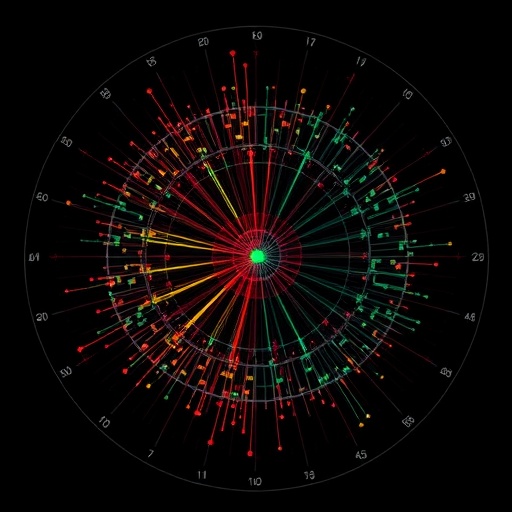Over the past decade, England’s intensive farming systems have undergone a remarkable transformation, significantly reducing their environmental footprints. A groundbreaking study, published in PLOS One, employs sophisticated data modeling to analyze farmland spanning 72,000 square kilometers from 2010 to 2021, revealing promising trends in the mitigation of greenhouse gas emissions and pollution from agricultural activities. This research highlights an 18% median decrease in both short- and long-term global warming potential, alongside a 21% reduction in acidification potential. Moreover, eutrophication potential, referring to nutrient runoff that contaminates aquatic ecosystems, has declined by 13%, illustrating an encouraging shift towards more eco-conscious farming.
The changes encapsulated by this analysis correspond to a fundamental restructuring within England’s agricultural landscape. Over the 11-year period, land devoted to general cropping expanded by close to 4%, while dairy farming contracted by 2%, signaling a shift in land use priorities. Livestock populations experienced marked declines: registered cattle numbers dropped nearly 25% by 2016 and further to 30% by 2021 compared to a baseline of 2010. Sheep and lamb numbers fell even more steeply, by over 40%. Such substantial reductions in livestock have played a pivotal role in curbing embedded emissions, especially methane, which is a potent contributor to global warming.
However, these environmental improvements have not been uniform across all regions or environmental indicators. Certain water management catchments demonstrated staggering reductions, up to 76% in some pollution parameters, whereas others exhibited minimal progress with improvements below 5%. This spatial heterogeneity underscores the complexity of linking environmental outcomes directly to specific management practices or regional policies, and highlights the need for localized strategies as part of broader sustainability efforts.
A closer examination of crop and land use dynamics between 2016 and 2021 reveals further complexity. There was an uptick in rotational grass, spring barley, peas, and fodder crops, accompanied by a notable decline in permanent grassland areas. Meanwhile, the category labeled ‘Other crops’ expanded considerably, reflecting an increasing diversification of less common crop varieties being integrated into farming systems. Such diversification may provide resilience benefits and soil health improvements but also signals an intensification as cereal farms grew specialized, dairy farms concentrated more cattle, and lowland grazing farms maintained higher densities of sheep and lambs.
This evolving agricultural architecture was accompanied by a nuanced intensification phenomenon. Though total livestock numbers decreased, the relative stocking densities on specialized farms increased, suggesting a trend towards more efficient but concentrated production systems. These shifts highlight the balancing act between optimizing output and controlling environmental impact. The modeling results suggest that changes are not solely driven by external policy but also by on-farm economic decisions and market forces influencing crop choices and livestock management.
Despite this encouraging trajectory, researchers caution that the correlation between modeled data and actual on-the-ground environmental monitoring remains difficult to establish unequivocally. While statistical modeling provides a robust overview of trends, direct empirical measurement and comprehensive monitoring are essential for validating these findings and ensuring that improvements translate into measurable environmental benefits in real-world contexts.
The report makes a compelling argument that routine, strategic assessments of farming’s environmental footprint are imperative for crafting informed national agricultural policies. As the pressures of climate change intensify, alongside rising concerns about energy security and resource depletion, it is critical that policymakers implement a multi-pronged approach. This approach should combine targeted regulation, financial incentives, and accessible practical advice that empowers farmers and land managers to adopt sustainable practices more rapidly and broadly.
Dr. Yusheng Zhang, lead author of the study, emphasizes the indispensable role of farming in sustaining a growing global population but stresses the urgency for sustainability: “Routine assessment of environmental footprints will be critical to building a climate-resilient and economically viable agricultural industry.” His statement underlines the dual necessity of feeding the population while preserving ecological integrity, reflecting the challenge at the heart of modern agriculture.
Professor Adie Collins, co-author, highlights the significance of structural changes such as reductions in livestock numbers and embedded emissions from agrochemicals and fuels. He notes that these transformations, evident in the model’s spatial patterns across England, showcase how farm restructuring can yield substantial environmental benefits. This insight is particularly pertinent in the current policy discourse revolving around the prospective Land Use Framework for England, which aims to harmonize agricultural productivity with environmental stewardship.
Moreover, the study sheds light on the socio-economic factors that underpin environmental progress. Adaptive shifts in crop mixes and livestock management are frequently responses to broader market and policy stimuli, indicating that environmental gains are intertwined with economic viability and farmer behavior. Understanding this relationship is crucial for designing policies that not only incentivize but also enable sustainable practices at scale.
The environmental footprint reductions are further supported by a decline in the use of embedded inputs like agrochemicals and fossil fuels. This decline lowers indirect emissions associated with crop production and livestock rearing, providing a more comprehensive picture of the sustainability gains achieved. It suggests that improvements are not solely the result of changing farm structures but also technological and management innovations reducing input intensity.
However, the persistence of uneven progress across regions signals the complexities inherent in translating national strategies into local action. Diverse soil types, climatic conditions, farm sizes, and socio-economic contexts across England mean that “one size fits all” policies may be inadequate. Tailored approaches that account for these variables will be necessary to sustain momentum and close the gaps in environmental performance.
As the agricultural sector navigates the intertwined challenges of food security, climate adaptability, and environmental sustainability, this study offers a beacon of hope. It illuminates a pathway by which evidence-based policy, informed by ongoing data analytics and responsive to regional particularities, can foster an agriculture system that is both productive and protective of natural resources.
In conclusion, the temporal evolution of the environmental footprints of intensive farming in England exemplifies a complex but achievable journey towards sustainability. The insights from this comprehensive modeling effort provide policymakers, farmers, and researchers with critical guidance on how structural changes and management refinements converge to reduce the sector’s impact on climate and ecosystems. Continued innovation, strategic assessment, and collaborative governance will be essential to scaling these benefits globally.
Subject of Research: Not applicable
Article Title: Temporal evolution of the environmental footprints of intensive farming across England
News Publication Date: 2-Oct-2025
Web References: http://dx.doi.org/10.1371/journal.pone.0331916
References: Provided article in PLOS One
Image Credits: Not specified
Keywords: intensive farming, environmental footprint, greenhouse gas emissions, acidification potential, eutrophication, sustainable agriculture, livestock reduction, crop diversification, England farming, climate change mitigation, agricultural policy, land use change
Tags: agricultural pollution mitigationdairy farming contractiondata modeling in agricultureeco-conscious farming practicesEngland agricultural transformationeutrophication potential declinefarming environmental impactgreenhouse gas emissions reductionintensive farming systems changesland use changes in farminglivestock population decreasesPLOS One study findings






